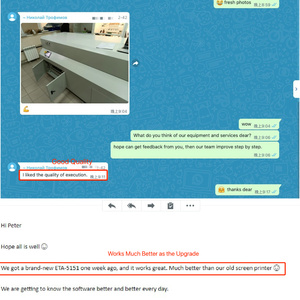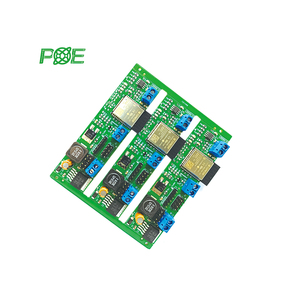(174187 products available)















































































































































































































Market Overview: The global market for PCB designing machines has experienced significant growth, driven by advancements in printed electronics and increasing demand from various sectors, including telecommunications and computing. According to Research and Markets, the market for consumer electronics printed board assemblies was projected to grow substantially, with product shipments expected to rise steadily through 2030. The Asia-Pacific region, notably China, has been a key player, benefiting from government incentives aimed at enhancing semiconductor self-sufficiency and advanced manufacturing capabilities. This region has a high concentration of PCB production, which is pivotal for meeting the growing demand for smart devices and miniaturized electronic components.
Industry Insights: The rise of smart and miniature electronic devices has notably influenced consumer behavior, pushing manufacturers to innovate in PCB design and production. The photolithography equipment market, closely related to PCB designing machinery, is expected to grow at a CAGR of 9.55%, reaching USD 22.47 billion by 2030, highlighting the increasing importance of precise and efficient manufacturing processes. Challenges such as high deployment costs and design limitations persist, prompting companies to seek cost-effective and sustainable solutions. Additionally, the trend towards eco-friendly manufacturing practices is reshaping customer preferences, with businesses increasingly adopting recyclable materials and energy-efficient technologies in their production lines. This evolving landscape presents opportunities for niche markets focused on sustainable and high-performance PCB solutions.
Some machines used for the PCB design mainly focus on the creation of the physical layers instead of the software components and electronic ones.
Fab house:
A PCB fab house is a specialized manufacturer that provides PCB fabrication services. Their primary focus is on producing the actual physical circuit boards based on the design files provided by the PCB designer. Fab houses have the expertise, equipment, and facilities to manufacture PCBs according to precise specifications. They work closely with PCB designers to ensure that the circuit boards are fabricated accurately and meet the required quality standards. PCB fab houses may offer additional services such as assembly, testing, and prototyping to provide comprehensive solutions for PCB production.
3D printer:
A PCB 3D printer is a specialized additive manufacturing device used to create printed circuit boards (PCBs) directly through 3D printing technology. Unlike traditional methods of PCB fabrication that involve subtractive processes, such as etching, 3D printers build up the layers of the PCB by depositing materials additively. This allows for greater design flexibility, faster prototyping, and the potential for creating complex geometries that may be challenging or impossible with conventional PCB fabrication techniques.
Routing machine:
A PCB routing machine, often referred to as a CNC (Computer Numerical Control) PCB routing machine or CNC PCB depaneling machine, is a specialized piece of equipment used in the manufacturing and assembly process of printed circuit boards (PCBs). This machine is designed to accurately cut, route, or depanel PCBs from larger substrate panels after the PCB fabrication process. The CNC routing machines use computer-controlled cutting tools to precisely route the individual PCBs out of the panels, ensuring clean and accurate separation.
A laser engraving machine:
A laser engraving machine for PCB (Printed Circuit Board) is a specialized device that uses laser technology to engrave or etch designs onto PCB substrates. PCBs are essential components used in the electronics industry to provide mechanical support and electrical connections for electronic components. The laser engraving machine allows for precise and accurate engraving of patterns, text, logos, and other designs onto the PCB material.
The following are some specifications that one must consider when choosing a suitable PCB design machine.
Size of the PCB
Larger devices will be able to work with bigger board sizes with an area of 884 mm x 584 mm max. (while unlimited, the maximum size will, of course, depend on the space available in your room)
Layers of the PCB
Machines with basic features can etch single-sided PCBs only. Upgrades are available later on to enable creating double-sided and multi-layered PCBs, too.
Drilling System
A drilling system that can create precise holes for component placement and connections. Consider machines with automatic drilling systems for greater precision and efficiency.
Worksurface Size
A suitable work surface area or bed size to accommodate PCBs of specific dimensions during the machining or soldering process.
Machine Types
This category includes laser machines, PCB router machines, CNC machines, and rotary tool machines, each of which works differently.
Speed Accuracy
The speed and accuracy of a PCB engraving machine determines how quickly and precisely it can engrave patterns onto the PCB substrate. Look for machines that offer high-speed engraving with fine precision for efficient PCB production.
Software Compatibility
The software compatibility of a PCB engraving machine refers to the design software it can work with. Ensure that the machine supports commonly used PCB design software for seamless integration and workflow.
Dust Collection System
A dust collection system integrated into a PCB milling machine helps remove and contain the dust and debris generated during the milling process. This system keeps the work area clean and prevents dust contamination on the PCB.
Bit Types
The specific types and sizes of bits used for engraving or milling PCBs, which can vary depending on the machine. These may include carbide-coated bits, micro-drill bits, and others designed for precise PCB manufacturing.
Double-Sided PCB Capability
The ability of a PCB milling machine to handle double-sided PCBs, allowing for the production of PCBs with components and connections on both sides. This feature enables more complex PCB designs and increases manufacturing versatility.
It is important to maintain a PCB machine so that it can carry out the tasks of etching and cutting effectively. Some generic tips that apply to all machines are:
PCB design machines are used in various industries because they produce layouts for PCBs used in different electronic devices. In the mobile phone industry, PCB design machines are employed to make PCBs that support cell phone components. This enables the fast production of mobile phones with flexible, multi-layered, and high-density PCBs.
Automotive companies use PCB design machines to create vehicle PCB layouts. These support diverse vehicle applications ranging from entertainment to safety. In the aerospace and defense industry, a PCB machine designer creates layouts for PCBs used in aircraft, satellites, and defense systems. Such devices need complex, high-precision electronics.
The medical equipment industry uses PCB machines to support the construction of PCs in medical diagnostic and monitoring equipment. Examples include imaging devices, patient monitoring systems, and therapeutic devices. The machine can also be used in IoT devices or smart appliances, as they need PCBs with integrated sensors and connectivity components.
In robotics and automation, PCB designers create layouts for the PCBs that support machines and robotics used in manufacturing lines and production units.
Universal scenarios exist for electronics design engineers and PCB board fabrication companies. These designers use the PCB machine to make a PCB layout in the format required for fabrication and assembly. On the other hand, fabrication companies need a designer to tailor the PCB to match an electronic product's needs.
The following buying guide will help anyone looking to buy a table-top PCB design machine for sale or small-scale CNC or Dremel-based machines for DIY home projects.
Budget:
Those looking to buy a professional-grade machine or a more massive lineup needs to consider the budget before investing. It is also essential to know what the business needs to focus on when buying the more massive setups or the more stringent qualities and specifications of smaller machines. If only 1-5 PCBs are to be made, it is better to invest in a more affordable tabletop/desktop model that fits the budget better.
Quality of end product:
This is where the business's needs come in. How important is the quality of the PCB to the end product? What type of components will be included? Will it be exposed to harsh environmental conditions? Will the end product need to have a specific look? If it is more important to meet the above criteria, it is essential to consider investing in a tabletop machine that uses UV light and photo resist to develop PCBs with production-grade quality. Photo etching can produce high-precision PCBs with accurate lines and spaces, better than DIY methods.
Ease of use:
The machine & its software should be handy to those designing PCBs with varying levels of experience. The best machines have intuitive controls that make setup and operation easier. Look for user-friendly design software, clear instructions, and the availability of tutorials for training purposes.
Support and service:
Find out what kind of customer support is provided with the machine. Product manuals and online resources will help before and after purchasing. Manufacturers that offer training and service ensure the system and operator's smooth functioning.
System's size and weight:
Manoeuvring capabilities will impact the system's size and weight, as many businesses may need to shift their in-house machines from one location to another. Understand how the machine handling system works to know what loading and off-loading mechanisms are required.
Power:
The main players in this field use a high-grade steel-aluminum composite for the frame and bi-pinned brushless AC motors for smooth adjustment and motion control. Knowing what kind of motors and material are necessary can help identify what power the system has coming behind it so that it can perform as necessary.
Special features:
Whether a single-layer and double-side PCB-making machine is needed, the process of lamination and derating it goes through, and other specifics should be known when discussing special features. Other widespread models have laser engraving, etching, and drilling all on one system that simplifies and speeds up the process.
Q1: What is the difference between the DIY PCB designing machine and the professional one?
A1: Generally, a professional PCB designer has high performance and can produce large quantities of PCBs. In contrast, a DIY machine is small and can create simple circuits.
Q2: What are the steps for designing a PCB with a PCB design machine?
A2: The main steps include: 1. Prepare the layout, 2. printing the design on the PCB material, 3. drilling holes for the components, 4. etching the board to create the circuit, 5. installing and soldering the components, and 6. testing the completed PCB.
Q3: Can people use a PCB design machine for small batch production?
A3: Yes, but it would be better to use it for large-scale production or low-to-medium-volume PCBs. The capacity of the machine may limit the speed and efficiency of small-batch production.